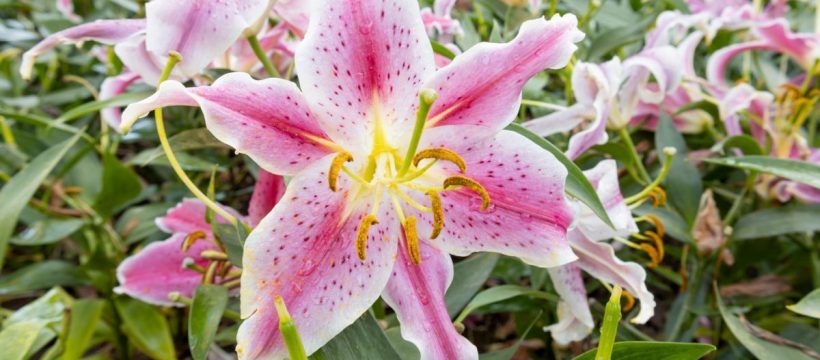
There are lilies with large, elegant trumpet-shaped flowers and others that are more open-faced and starlike. There are delicate, airy lilies with petals that curve back on themselves that naturalise well in light shade. Pots filled with lilies can line a path for a special occasion, or be positioned in a border for added drama. To maintain the stunning appearance of these plants, Monty Don has taken to his monthly gardening blog to share his top tips for planting lilies in pots.
He said: “Plant lilies in pots for one of the best and most fragrant of summer displays.
“Most lilies like an ericaceous soil (an acidic compost) but Madonna lilies, which are one of the first to flower, prefers an alkaline soil and will return year after year given the right conditions.”
However, the gardening pro noted that gardeners will not go wrong if they provide good drainage and a nice, loose compost.
Monty claims that he achieves this by mixing in plenty of leafmould and grit into a bark-based general purpose compost.

The 67-year-old added that even by just adding perlite or vermiculite, it will “help greatly”.
Gardeners should plant the scaly bulbs with about four inches of compost above the crown and put them somewhere lightly shaded to grow.
Keep them well watered and move them to their final position when the buds develop in May and June.
Monty added: “In general lilies like shady roots and sunny flowers so a west or east facing sheltered spot is ideal for their flowering performance.”
Don’t miss…
Mrs Hinch fans ‘rave’ over simple method to descale kettle [COMMENT]
Five minute ‘game-changing’ method to remove ‘tough’ air fryer grime [INSIGHT]
‘Best’ solution to remove tissue from washed clothes in ‘five minutes’ [TIPS]
Lily bulbs grow in a continuous cycle throughout the year and how gardeners treat the plant after flowering determines how the following season will turn out.
Deadheading is what gardeners need to do when lilies have finished flowering. This involves removing spent flowers.
Lily blooms can be cut off and used as cut flowers for decoration and making floral displays either alone or with other flowers.
The blooms that were not cut off wither and become unattractive hanging on the stems.

Each of the spent flowers should be picked as it withers which can be easily done by hand.
The flowers can be broken off using just fingers or cut off using a pair of shears.
Lilies don’t flower more than once per season, so removing the spent flowers hardily promotes flowering.
However, the faded and withered flowers should be removed to make the plant doesn’t waste its energy making seeds. If the lily flowers are pollinated, they shrivel, fade, and make way for seed pods.


Gardeners who plan on using the same bulbs the following season, they don’t want the seeding to occur.
This is because the seed pods will consume the plant’s energy which could have been stored as carbohydrates in the bulb. Deadheaded lilies show better growth the following season.
The second reason why these plants need to be deadheaded is that it cleans up the appearance of the plant and the pot or garden in general.
It is worth noting that gardeners should not take off any leaves during deadheading because the plant still needs them to make energy.
Source: Read Full Article
